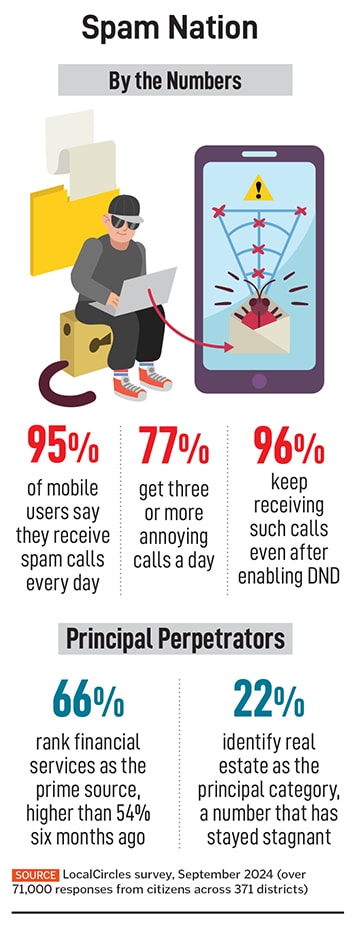Can AI end India’s spam call epidemic? These startups think so
Inside India’s race to outsmart spam calls using artificial intelligence


Voice is the next periphery for artificial intelligence (AI). After chatbots and image generators, startups are now teaching AI to talk—and more importantly, to answer. In India, where spam calls often outnumber genuine ones, some startups are betting that AI call assistants can make phone anxiety a thing of the past.
Truecaller introduced its AI-powered service Truecaller Assistant for paying users in 2023, while SpiderX AI began offering a similar service for enterprises late last year with Phone AI. Both remain paid solutions.
In October, a new contender entered the ring with a bold claim—it’s made in India, built for India and free. Hyderabad-based Equal launched Equal AI on October 2, offering early access to the first 10,000 Android users in Delhi-NCR. It plans to launch the app in other major cities of the country in phases.
India remains one of the worst-hit countries in the world when it comes to spam calls. A September 2024 LocalCircles survey found that 96 percent of Indians receive unsolicited calls daily, even after registering for Do Not Disturb (DND). According to data released by the Ministry of Home Affairs, Indians lost ₹7,000 crore to online financial frauds in the first five months of 2025.
To counter this, the Telecom Regulatory Authority of India has tightened norms. Since February, telemarketers are barred from using 10-digit numbers that resemble personal mobile lines, while telecom companies face fines of up to ₹10 lakh for failing to curb spam. Despite these measures, the menace continues.
For years, Truecaller has been the go-to caller ID app, flagging suspicious numbers. But as scam calls have grown more sophisticated, users have become even more anxious to pick up unknown numbers.
Now, a new generation of startups is tackling the problem with AI.
“Equal AI is designed to solve this at scale. The app takes the call for you; it listens, speaks, transcribes and shares what’s happening live so you decide if it’s worth your time. It’s like having your personal secretary—giving back what matters to you the most: Time,” Keshav Reddy, founder of Equal AI, tells Forbes India. The user can jump into the call anytime.
According to Reddy, the key differentiator is that Equal AI isn’t just a caller ID or screener, but a fully conversational, AI-powered assistant built specifically for India. It speaks English, Hindi and Hinglish, and can handle dynamic interactions—whether it’s giving delivery instructions, filtering spam or just clarifying intent.
“Unlike global screeners, Equal AI understands Indian names, accents and contexts,” adds Reddy, the third-generation scion of the GVK family. “It uses 15 mini AI agents per call to interpret whether it’s delivery, loan, real estate or fraud, and respond accordingly.” Equal AI aims to reach one million daily active users by mid-2026, and plans to shift to a freemium model at some point. With nearly a billion smartphone users in India, the opportunity is massive.
Equal isn’t alone in this AI call revolution.
Mitra, developed by Sai Mandava, a former AI researcher at Berkeley, offers similar call-handling features in multiple languages, including Hindi. Currently available only in the US, Canada, Australia, South America and Europe, the app could soon launch in India.
“We have plans to launch in India, but it’s been a bit tough since India’s telecom regulations don’t currently allow Mitra to function as intended with VoIP (Voice over Internet Protocol) and related services. We’re actively looking at different avenues to bring Mitra to India,” Mandava tells Forbes India.
SpiderX AI, dual-headquartered in the US and India, launched Phone AI in 2024, primarily targeting businesses. While it was conceptualised in California, the app was built in India, said a company spokesperson. Queries sent to Truecaller remained unanswered.
Under the Digital Personal Data Protection Act (2023), explicit consent is required for processing personal data. But who must obtain it?
“This will depend on how the app is being operated or used,” says Shahana Chatterji, partner at Shardul Amarchand Mangaldas & Co. “If it is an integrated enterprise app, then in all probability, the provider of the app would be classified as a processor and would not, strictly speaking, have consent obligations under Indian law. If, however, the app was provided more on a B2C basis, it is more likely to be classified as a data fiduciary and therefore would need to obtain consent.”
Chatterji adds that these consent requirements apply even to entities outside India if they meet the DPDP Act’s applicability criteria.
Consent is important because it gives users clarity on how their data will be used. “User understanding over who has access or how their personal data is shared is set to grow. Now if you add to this the use of AI layers on assist apps (or any other apps), there is added complexity on how personal data is being processed. There are also added complexities about the risk that is created from reliance on outcomes from AI-based apps. We will see a growing prominence of disclosure and notice mechanisms to deal with these risks,” Chatterji says.
Apart from consent, the real test lies in whether users will trust AI to answer their calls.
“India leads the world in trusting AI so I won’t be surprised if AI assistants become common, especially if they are free. My only concern would be how the data is stored and used,” says an AI expert, admitting that he is not familiar with the business model of such apps.
However, on data privacy, Reddy says since the app only answers unknown numbers, there are no concerns. User data is stored securely within India, ensuring privacy and sovereignty.
For now, startups like Equal AI are betting that in a country where the phone can buzz 20 times a day, an AI voice on the line might soon feel less like science fiction and more like relief.
First Published: Oct 23, 2025, 14:57
Subscribe Now(This story appears in the Oct 31, 2025 issue of Forbes India. To visit our Archives, Click here.)
